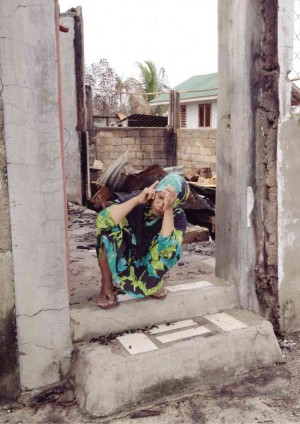Zamboanga settlers decry relocation plan

GONE are the houses on stilts in Barangay Santa Barbara. Residents were allowed to return to the area but were advised to leave before 5 p.m. for the government’s debris management. PHOTOS BY JULIE ALIPALA/INQUIRER MINDANAO
ZAMBOANGA CITY—City government officials have assured informal settlers in villages ravaged by three weeks of fighting between government security forces and Moro gunmen in September that they are included in the rebuilding efforts.
Earlier, informal settlers, including those renting homes in the war-torn villages of Mariki, Rio Hondo, Kasanyangan, Santa Catalina and Santa Barbara, decried what they labeled as unfair treatment by city officials when they were allowed only briefly to go back to gather the belongings they left behind as they fled the violence last month.
Other villagers, especially those from Santa Catalina, were allowed to stay longer because they showed land titles or other documents that validated their status as permanent residents.
Mayor Ma. Isabelle Climaco-Salazar said that under the massive rebuilding program, to which President Aquino pledged more than P3 billion in funds, displaced informal settlers were also made a priority.
But Salazar said they had to agree to be relocated to either of two barangays—Taluksangay or Tulungatung—which are about 10 kilometers outside the city proper.
Article continues after this advertisement“Priority is given to informal settlers willing to be relocated to sites in Tulungatung or Taluksangay,” she said.
Article continues after this advertisementBernardita Ingson, a mother of six who had lived with her family in Santa Barbara for the past 20 years, said it was the only place for her and her family. “Lustre (Street) is more convenient for us. The school is near and we do not have to spend for fare when going to town,” she said.
Watch repair man Reynaldo Zamora, 50, said he did not want to leave Santa Barbara as well. “I grew up there. My family may not have a property there but I have lived there since childhood. It would be doubly painful for me to leave the place I grew up in despite being poor,” he said.
Zamora felt the city government was being unfair to informal settlers. “We did not ask for what happened, why not allow us to restart life in the only place we grew up in?” Zamora asked.
He said they did not mind rebuilding their lives from scratch on their own but added that they would welcome help from the city government.
For those insisting on returning to their former places, Santa Catalina in particular, even if they did not own a piece of property there, Salazar said they had to stay longer in evacuation centers while the cleanup and reconstruction were being done.
“These people do not have houses to return to because the place was destroyed. We intend to clear up the place first in order to rebuild it,” she said.

AN OLD WOMAN (above) sits on the doorstep of her burned house as she speaks to her daughter on the phone detailing the extent of the damage in Barangay Santa Barbara.
Salazar said that under the rebuilding plan, temporary bunkhouses would be built for residents who have land titles or documents but no longer have houses to return to.
She said the city government was banking on the involvement of its partners, including building experts from the University of the Philippines, for a speedy reconstruction program.
“Hopefully within six months, 10 percent of the permanent shelters should have been established already and in a year’s time, the rebuilding of the new communities in Mariki, Rio Hondo, Kasanyangan, Santa Catalina and Santa Barbara should have been completed,” Salazar said.
Some landowners, like the Evangelista family of Santa Catalina, said the city government might need to consult them in the case of some families, which did not have titles on pieces of property they were claiming to have owned.
Jordan Evangelista, a member of the family that owns large parcels of land, said their property in Kasanyangan was occupied by many settlers who were still paying for the land.
He said these settlers did not have titles yet.
“We have the [original] titles and the list of those who still owe us,” Evangelista said. Julie Alipala, Inquirer Mindanao